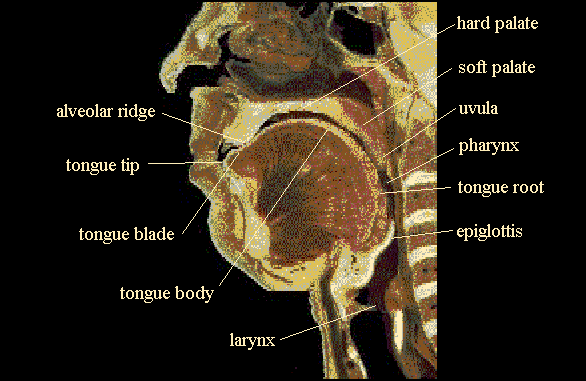Anatomy of the vocal tract

In addition to their normal names, many of the parts of the vocal
tract have fancy names derived from Latin and Greek. The adjectives
we use to describe sounds made with each part are usually based on
the Latin/Greek name.
| Normal name |
Fancy name |
Adjective |
|---|
| lips | labia | labial |
| teeth | | dental |
| alveolar ridge | | alveolar |
| (hard) palate | | palatal |
| soft palate | velum | velar |
| uvula | | uvular |
| upper throat | pharynx | pharyngeal |
| voicebox | larynx | laryngeal |
| tongue tip | apex | apical |
| tongue blade | lamina | laminal |
| tongue body | dorsum (back) | dorsal |
| tongue root | | radical |
In phonetics, the terms velum, pharynx, larynx, and
dorsum are used as often or more often than the simpler names.
- alveolar ridge
- A short distance behind the upper teeth is a change in
the angle of the roof of the mouth. (In some people it's quite
abrupt, in others very slight.) This is the alveolar ridge.
Sounds which involve the area between the upper teeth and this
ridge are called alveolars.
- (hard) palate
- the hard portion of the roof of the mouth. The term "palate" by
itself usually refers to the hard palate.
- soft palate/velum
- the soft portion of the roof of the mouth, lying behind the hard
palate. The tongue hits the velum in the sounds [k], [g], and
[
 ].
The velum can also move and serves as the "gatekeeper" of the
nasal cavity. Normally during speech, the velum is in a raised
position and does
not allow air into the nose, but during some sounds (the nasal
sounds) it lowers and allows air to flow through the nose.
].
The velum can also move and serves as the "gatekeeper" of the
nasal cavity. Normally during speech, the velum is in a raised
position and does
not allow air into the nose, but during some sounds (the nasal
sounds) it lowers and allows air to flow through the nose.
- uvula
- the small, dangly thing at the back of the soft palate.
The uvula vibrates during the r sound in many French dialects.
- pharynx
- the cavity between the root of the tongue and the walls
of the upper throat.
- tongue blade
- the flat surface of the tongue just behind the tip.
- tongue body/dorsum
- the main part of the tongue, lying below the hard and soft
palate. The body, specifically the back part of the body (hence "dorsum",
Latin for "back"), moves to make vowels and many consonants.
[note]
- tongue root
- the lowest part of the tongue in the throat
- epiglottis
- the fold of tissue below the root of the tongue. The
epiglottis helps cover the larynx during swallowing, making sure
(usually!) that food goes into the stomach and not the lungs. A few
languages use the epiglottis in making sounds. English is fortunately
not one of them.
- vocal folds/vocal cords
- folds of tissue stretched across the airway to the lungs.
They can vibrate against each other, providing much of the sound
during speech.
- glottis
- the opening between the vocal cords. During a glottal
stop, the vocal cords are held together and there is no opening between them.
- larynx
- the structure that holds and manipulates the vocal cords.
The "Adam's apple" in males is the bump formed by the front part
of the larynx.
Note: Many books try to distinguish between
sounds made with the backest part of the tongue body and sounds made
with a fronter part
of the tongue body. You may want to learn this distinction if you have
nothing better to do with your time. I will consistently refer to all
sounds made with the tongue body as "dorsal".
To look at pictures of slices of people till your heart's content, check
out the
Visible Human Project.
Next: Describing English consonants;
Up: Table of contents
 ].
The velum can also move and serves as the "gatekeeper" of the
nasal cavity. Normally during speech, the velum is in a raised
position and does
not allow air into the nose, but during some sounds (the nasal
sounds) it lowers and allows air to flow through the nose.
].
The velum can also move and serves as the "gatekeeper" of the
nasal cavity. Normally during speech, the velum is in a raised
position and does
not allow air into the nose, but during some sounds (the nasal
sounds) it lowers and allows air to flow through the nose.
